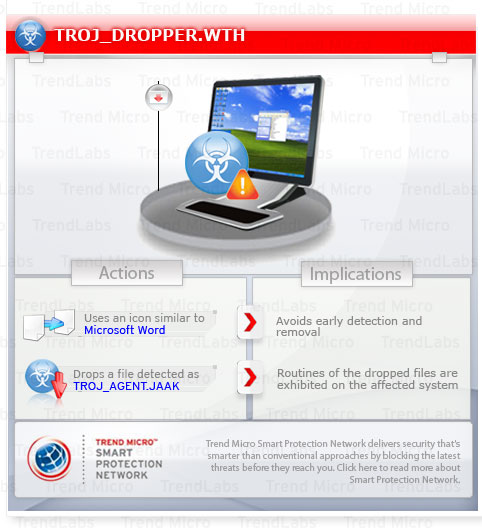TROJ_DROPPER.WTH
Windows 2000, Windows XP, Windows Server 2003


Threat Type: Trojan
Destructiveness: No
Encrypted: Yes
In the wild: Yes
OVERVIEW
This Trojan uses social engineering methods to lure users into performing certain actions that may, directly or indirectly, cause malicious routines to be performed. Specifically, it makes use of the Summit on the Development Issues of G-20 of Korea.
To get a one-glance comprehensive view of the behavior of this Trojan, refer to the Threat Diagram shown below.

It drops a file detected as TROJ_AGENT.JAAK.
It drops a non-malicious .DOC file. When the said file is opened, it executes an instance of Microsoft Word. MS Word then loads the file as a normal .DOC file.
This Trojan bears the file icons of certain applications to avoid easy detection and consequent removal. It executes then deletes itself afterward.
It executes the files it drops, prompting the affected system to exhibit the malicious routines they contain.
TECHNICAL DETAILS
Arrival Details
This Trojan may be downloaded from the following remote sites:
- http://www.{BLOCKED}trickre.com/issues/G20IssuesPaper.zip
Installation
This Trojan bears the file icons of the following applications:
- Microsoft Word document
It executes then deletes itself afterward.
Autostart Technique
This Trojan creates the following registry entries to enable automatic execution of dropped component at every system startup:
HKEY_CURRENT_USER\Software\Microsoft\
Windows\CurrentVersion\Run
AdobeUpdate = "%User Temp%\Wininet.exe"
Dropping Routine
This Trojan drops the following files:
- {malware path}\Korean G20 Development Issue Paper.doc - non-malicious file
It drops the following files:
- %User Temp%\Wininet.exe - detected as TROJ_AGENT.JAAK
(Note: %User Temp% is the current user's Temp folder, which is usually C:\Documents and Settings\{user name}\Local Settings\Temp on Windows 2000, XP, and Server 2003.)
It executes the files it drops, prompting the affected system to exhibit the malicious routines they contain.
Other Details
This Trojan opens the following files:
- {malware path}\Korean G20 Development Issue Paper.doc
It does the following:
- Executes an instance of Microsoft Word when the file {malware path}\Korean G20 Development Issue Paper.doc is opened. MS Word then loads the file as a normal .DOC file.
SOLUTION
Step 1
For Windows XP and Windows Server 2003 users, before doing any scans, please make sure you disable System Restore to allow full scanning of your computer.
Step 3
Delete this registry value
Important: Editing the Windows Registry incorrectly can lead to irreversible system malfunction. Please do this step only if you know how or you can ask assistance from your system administrator. Else, check this Microsoft article first before modifying your computer's registry.
- In HKEY_CURRENT_USER\Software\Microsoft\Windows\CurrentVersion\Run
- AdobeUpdate=%User Temp%\Wininet.exe
- AdobeUpdate=%User Temp%\Wininet.exe
Step 4
Search and delete this file
- {malware path}\Korean G20 Development Issue Paper.doc
Step 5
Scan your computer with your Trend Micro product to delete files detected as TROJ_DROPPER.WTH. If the detected files have already been cleaned, deleted, or quarantined by your Trend Micro product, no further step is required. You may opt to simply delete the quarantined files. Please check this Knowledge Base page for more information.
Did this description help? Tell us how we did.


